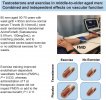[OA] Burden of Male Hypogonadism and Major Comorbidities, and the Clinical, Economic, and Humanistic Benefits of Testosterone Therapy
Male hypogonadism and major comorbidities such as type 2 diabetes mellitus, obesity, cardiovascular disease, and osteoporosis appear closely connected, forming a vicious cycle that leads to further hypogonadism. This narrative review provides a comprehensive overview of the current literature on the overall burden of male hypogonadism alongside related comorbidities, and how this may be alleviated through testosterone therapy.
Observational and clinical data demonstrate that the interaction of male hypogonadism and its related comorbidities is associated with increased mortality, cardiovascular event risk and reduced quality of life. Evidence from epidemiological and registry-based studies shows that this clinical and humanistic burden translates to increased economic burden on health-care systems, through increased physician visits, medical claims, and drug costs.
Male hypogonadism can be managed with testosterone therapy, which is intended to normalize testosterone concentrations and thereby reduce both hypogonadism symptoms and risk of comorbidities. Clinical and observational data suggest that in males with hypogonadism, testosterone therapy rapidly and sustainably improves glycemia, reduces risk of progression to diabetes, leads to significantly reduced waist circumference and fat mass, while providing significant positive effects on cardiovascular event risk and bone density. Significant and sustained improvement in patient-reported erectile function, urinary function, and aging male symptoms have also been shown.
Economic evaluations have estimated that reduced comorbidity risk following testosterone therapy may lead to cost-savings, with one study estimating yearly inpatient savings of £3732 for treating comorbidities after intervention.
A major unmet need exists in the area of male hypogonadism, particularly related to common comorbidities. Options for treatment include testosterone therapy, which has been shown to alleviate the clinical, economic, and humanistic burden associated with these conditions. As the prevalence of male hypogonadism is likely to increase globally, and this condition may be currently underdiagnosed, cost-saving testosterone therapies should be increasingly considered to manage hypogonadism.
Yeo S, Holl K, Peñaherrera N, Wissinger U, Anstee K, Wyn R. Burden of Male Hypogonadism and Major Comorbidities, and the Clinical, Economic, and Humanistic Benefits of Testosterone Therapy: A Narrative Review. Clinicoecon Outcomes Res. 2021 Jan 12;13:31-38. doi: 10.2147/CEOR.S285434. PMID: 33488103; PMCID: PMC7814241. Burden of Male Hypogonadism and Major Comorbidities, and the Clinical, | CEOR
Male hypogonadism and major comorbidities such as type 2 diabetes mellitus, obesity, cardiovascular disease, and osteoporosis appear closely connected, forming a vicious cycle that leads to further hypogonadism. This narrative review provides a comprehensive overview of the current literature on the overall burden of male hypogonadism alongside related comorbidities, and how this may be alleviated through testosterone therapy.
Observational and clinical data demonstrate that the interaction of male hypogonadism and its related comorbidities is associated with increased mortality, cardiovascular event risk and reduced quality of life. Evidence from epidemiological and registry-based studies shows that this clinical and humanistic burden translates to increased economic burden on health-care systems, through increased physician visits, medical claims, and drug costs.
Male hypogonadism can be managed with testosterone therapy, which is intended to normalize testosterone concentrations and thereby reduce both hypogonadism symptoms and risk of comorbidities. Clinical and observational data suggest that in males with hypogonadism, testosterone therapy rapidly and sustainably improves glycemia, reduces risk of progression to diabetes, leads to significantly reduced waist circumference and fat mass, while providing significant positive effects on cardiovascular event risk and bone density. Significant and sustained improvement in patient-reported erectile function, urinary function, and aging male symptoms have also been shown.
Economic evaluations have estimated that reduced comorbidity risk following testosterone therapy may lead to cost-savings, with one study estimating yearly inpatient savings of £3732 for treating comorbidities after intervention.
A major unmet need exists in the area of male hypogonadism, particularly related to common comorbidities. Options for treatment include testosterone therapy, which has been shown to alleviate the clinical, economic, and humanistic burden associated with these conditions. As the prevalence of male hypogonadism is likely to increase globally, and this condition may be currently underdiagnosed, cost-saving testosterone therapies should be increasingly considered to manage hypogonadism.
Yeo S, Holl K, Peñaherrera N, Wissinger U, Anstee K, Wyn R. Burden of Male Hypogonadism and Major Comorbidities, and the Clinical, Economic, and Humanistic Benefits of Testosterone Therapy: A Narrative Review. Clinicoecon Outcomes Res. 2021 Jan 12;13:31-38. doi: 10.2147/CEOR.S285434. PMID: 33488103; PMCID: PMC7814241. Burden of Male Hypogonadism and Major Comorbidities, and the Clinical, | CEOR





